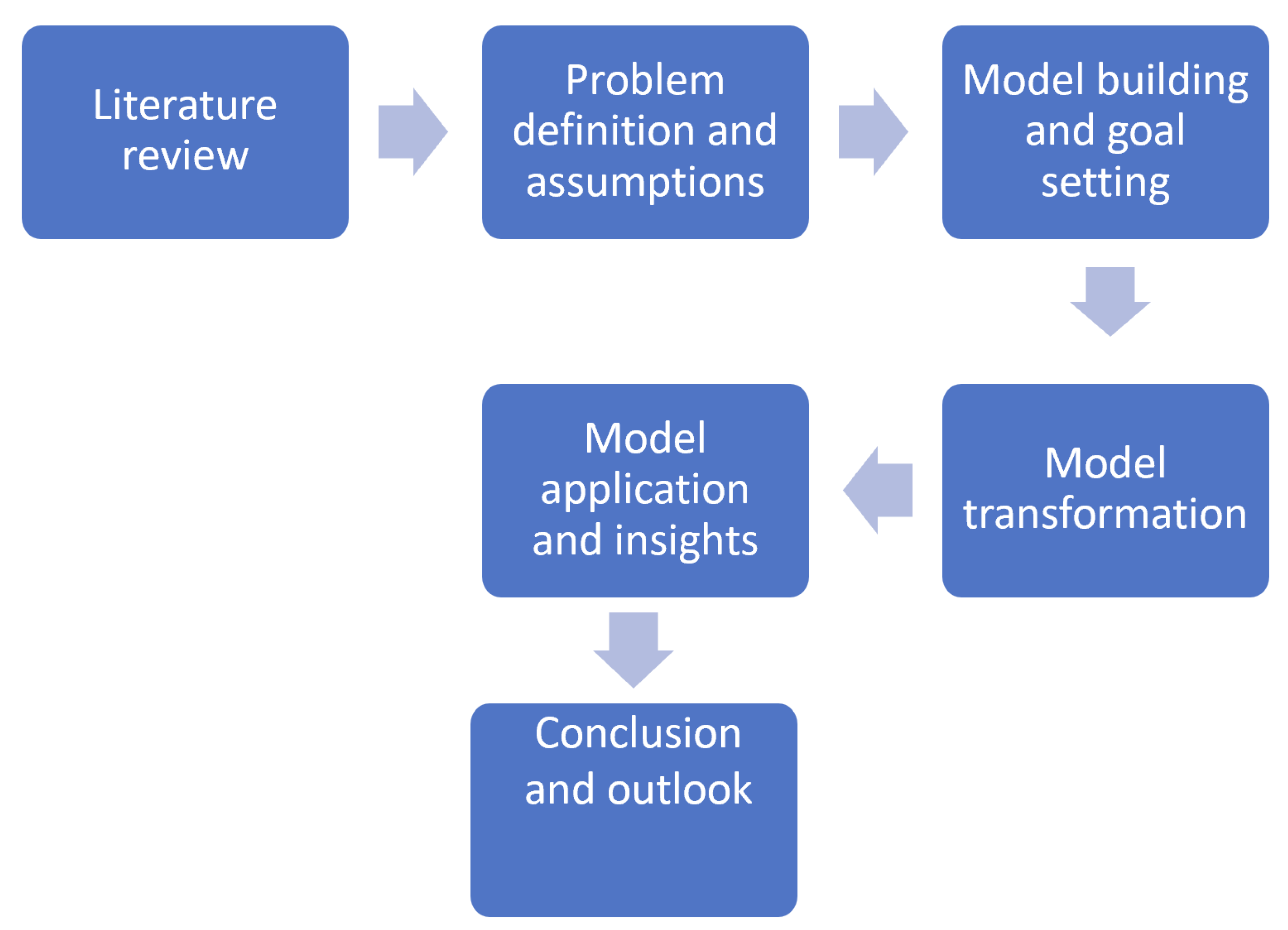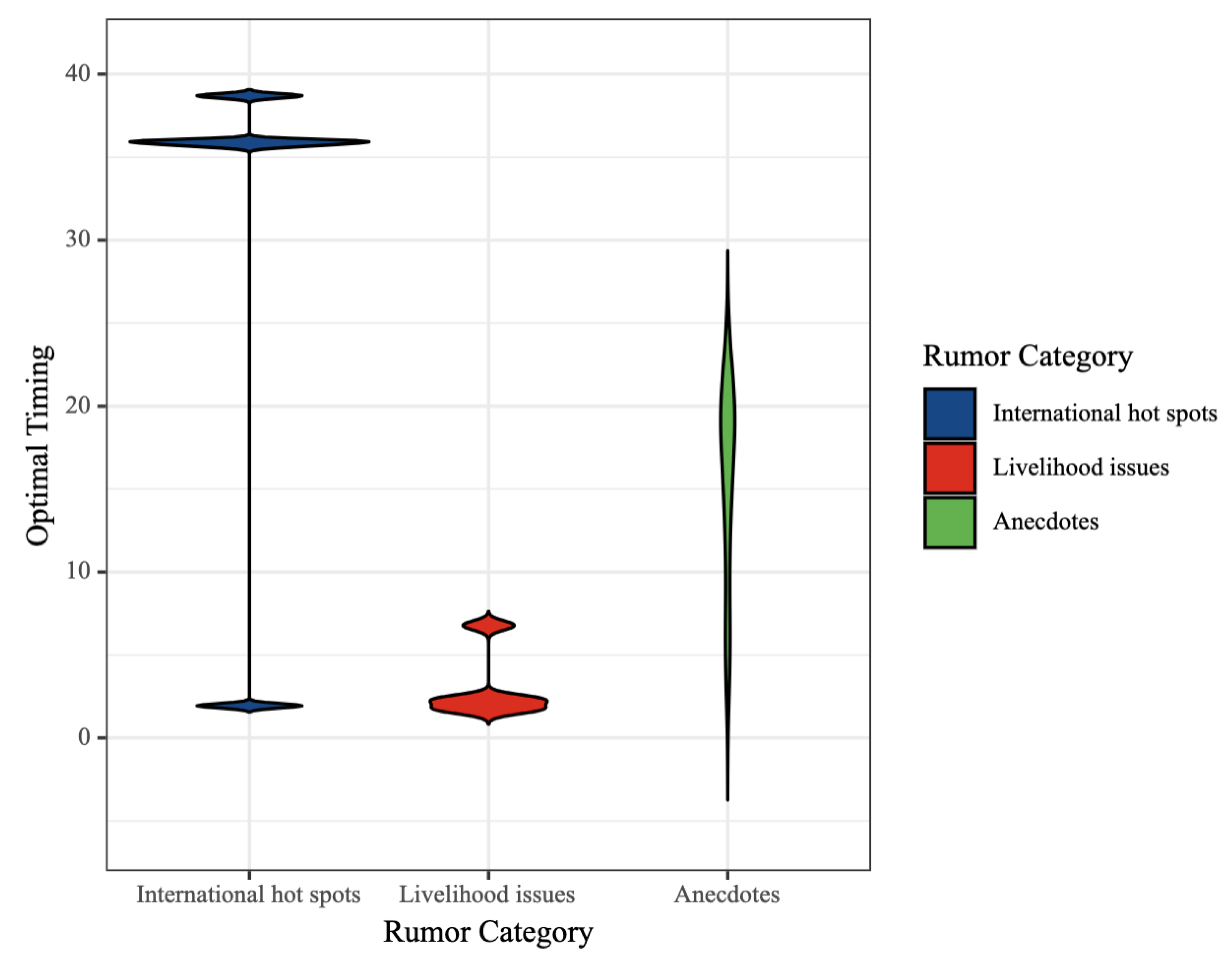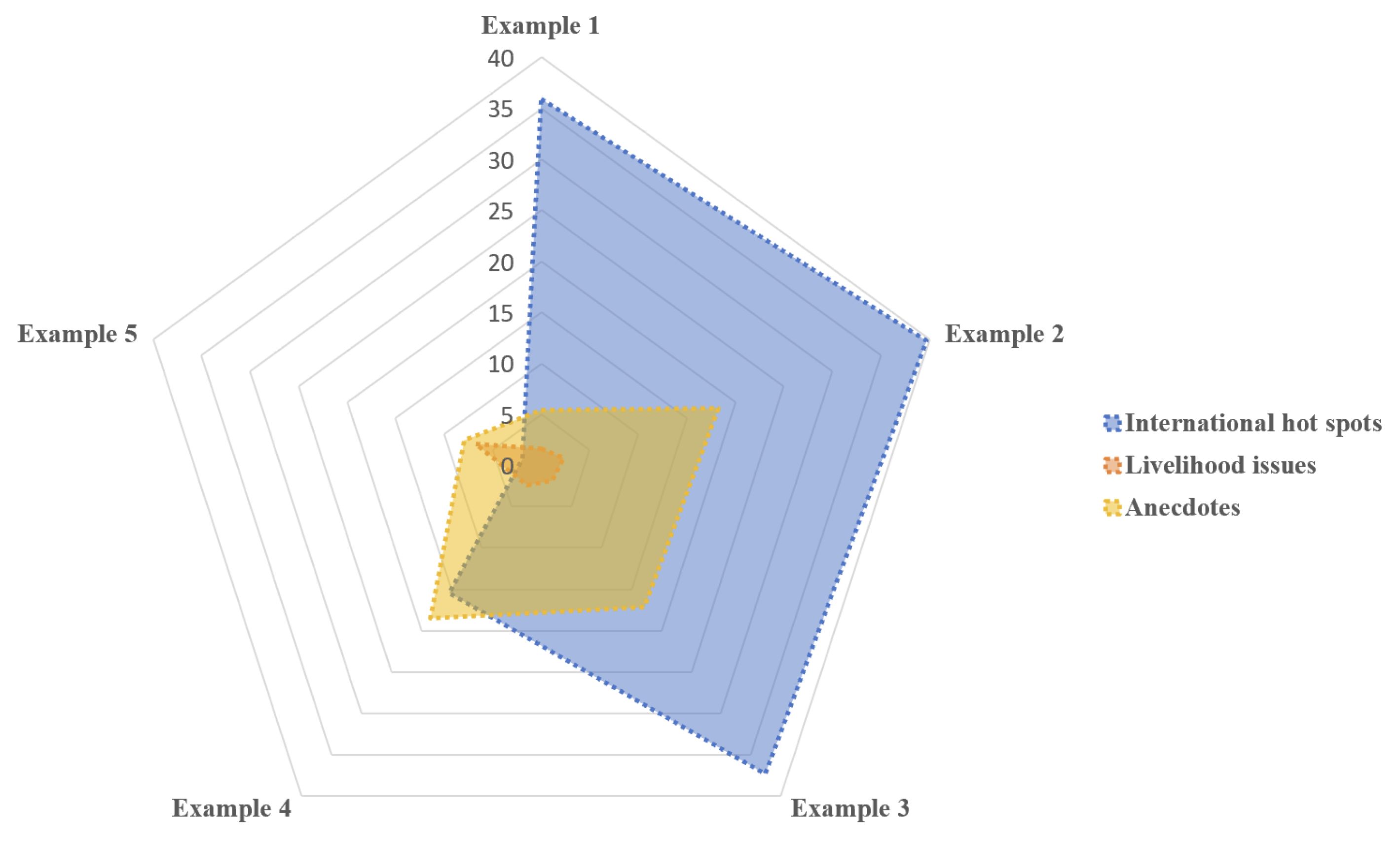A Mathematical Optimization Model Designed to Determine the Optimal Timing of Online Rumor Intervention Based on Uncertainty Theory
Abstract
:1. Introduction
2. Literature Review
3. Technical Process
- Step 1:
- Literature Review and Issue Identification
- Collect and analyze the relevant literature and research results on online rumor management.
- Identify key issues and challenges within the current research landscape.
- Step 2:
- Problem Definition and Hypothesis Formulation
- Define the primary research question and establish corresponding hypotheses.
- Outline the research framework and develop an analytical model as the foundation.
- Step 3:
- Model Development and Objective Setting
- Create a multi-agent intervention model that includes self-media and netizens.
- Determine the optimal intervention time and its influencing factors.
- Establish relevant objective functions and constraints.
- Step 4:
- Model Formalization and Mathematical Approaches
- Formalize and transform the intervention model using mathematical techniques.
- Explore mathematical theories suitable for addressing uncertainties.
- Step 5:
- Model Application and Insights
- Apply the model to real-world cases and evaluate its effectiveness.
- Provide comprehensive insights and analyze factors affecting intervention timing.
- Step 6:
- Conclusion and Future Directions
- Summarize the key findings and conclusions drawn from the study.
- Discuss study limitations and propose directions for future research.
4. Problem Description
5. Model Building
5.1. Parameter Introduction
| indicates the timing of the regulatory intervention, ; | |
| indicates the time when the online rumor began to be published, ; | |
| indicates the proportional coefficient of the spread rate of online rumors to the attention of online rumors, ; | |
| indicates the highest threshold for the spread rate of online rumors; | |
| indicates the proportional coefficient of the variable intervention cost to the regulatory authority and the duration of the online rumor’s publication, ; | |
| indicates the proportion of users who forwarded true information related to category i online rumors by category k entities, , ; | |
| indicates the correlation coefficient between the bonuses of the subject of category k and the proportion of users who retweet true information related to the online rumors in category i, , ; | |
| indicates the degree of consumption of the fixed intervention costs for the regulatory authorities; | |
| indicates the highest threshold value for the total cost consumption of the regulatory authority. |
5.2. Multi-Objective Functions
5.2.1. Minimize the Spread Rate of Online Rumors
5.2.2. Minimize the Total Cost of the Intervention
5.3. Opportunity Constraints and Multi-Objective Models
5.3.1. Opportunity Constraints on the Propagation Rate of Online Rumors
5.3.2. Constraints on the Opportunity to Intervene in the Degree of Total Cost Consumption
5.3.3. Timing Constraints on Interventions
5.3.4. Multi-Objective Model
- is the constraint on the propagation rate of online rumors;
- is the constraint on the degree of consumption of the total cost of the intervention.
5.4. An Equivalent Form of the Model
6. Comparative Experiments
6.1. Parameter Settings
6.2. Solve and Analyze
6.2.1. Analysis of Results Obtained When the Participants Have the Same Weight
- a.
- The Role of Self-Media
- b.
- Impact of Passive Media Response
- c.
- Influence of Netizen Participation
- International Hot Spots: In the absence of external influences, regulators should act during the birth period for optimal impact and cost-effectiveness. Once self-media and netizens engage, intervention should be delayed until the rumor’s decline (extinction period).
- Livelihood-Related Rumors: Independent of external participation, early intervention during the rumor’s birth is advised. With the involvement of self-media and netizens, an even earlier intervention is preferable.
- Anecdotal Rumors: When self-media actively disseminates true information, intervention should occur at the rumor’s inception. If self-media is passive but netizens are active, regulators should act during the rumor’s decline. Specifically, if self-media is negatively responsive while netizens are positively engaged, an early extinction-period intervention is ideal. Conversely, with passive netizen reactions, the middle extinction period is recommended.
6.2.2. Analysis of Results Obtained When Participants Have Different Weights
- a.
- Influence of Negative Responses from Self-Media and Netizens
- b.
- Impact of Active Responses from Self-Media and Netizens
- International Hot Spot Online Rumors: The optimal intervention time for international hot spot online rumors shifts from the birth period to the extinction period. This change suggests that interventions become more effective later in the rumor’s life cycle, when self-media responds negatively and netizen participation is high.
- Anecdotal Online Rumors: Similarly, the best timing for intervening in anecdotal online rumors moves from the diffusion period to the extinction period. This indicates that delaying an intervention until the later stages could be more beneficial when these actors are engaged.
- Online Rumors Related to People’s Livelihoods: The intervention timing for rumors concerning people’s livelihoods has seen a slight adjustment, shifting from the middle to the early birth period. Although this shift is less dramatic compared to the other types of rumors, it underscores the importance of early intervention in such cases.
- a.
- Intervention without Other Entities’ Involvement
- b.
- Decision Making Based on the Focus of the Intervention
- c.
- Role of Self-Media and Netizen Involvement
6.3. Effectiveness of Models
6.4. Revelation and Analysis
- The Impact of Self-Media and Netizens: The involvement of self-media and netizens significantly influences the optimal timing for interventions. For international hot spot rumors, the optimal intervention period shifts from the birth period to the extinction period. In contrast, for rumors concerning people’s livelihoods, this shift is less pronounced, moving from the middle to the early birth period. Notably, self-media’s active engagement drastically changes the best intervention timing of anecdotal rumors from the extinction to the birth period.
- Optimal Timing with Self-Media and Netizens’ Involvement: Regardless of whether regulatory authorities prioritize governance effectiveness or cost-efficiency, the presence of self-media and netizens dictates that the best time to intervene in international hot spot rumors is during their extinction period. For rumors related to people’s livelihoods, early intervention, right at the beginning of their emergence, proves most effective.
- Anecdotal Rumors Without External Participation: When anecdotal rumors circulate without the participation of self-media or netizens, the regulatory focus—whether on governance effectiveness or cost reduction—significantly affects the optimal intervention timing. Focusing on governance leads to an intervention during the extinction period, whereas prioritizing cost reduction shifts this to the diffusion period.
7. Conclusions
Author Contributions
Funding
Data Availability Statement
Conflicts of Interest
Appendix A
References
- Zhao, J.; Liu, H.; Dong, H.; Zhang, W.; Xin, J.; Zhou, X.; Wang, Z.; Zhang, X.; Ren, X.; Zhang, S. A synergistic study of policy and literature on rumor governance. Heliyon 2024, 10, e29995. [Google Scholar] [CrossRef] [PubMed]
- Jung, A.-K.; Ross, B.; Stieglitz, S. Caution: Rumors ahead—A case study on the debunking of false information on Twitter. Big Data Soc. 2020, 7, 2053951720980127. [Google Scholar] [CrossRef]
- Jiang, M.; Gao, Q.; Zhuang, J. Reciprocal spreading and debunking processes of online misinformation: A new rumor spreading—Debunking model with a case study. Phys. A Stat. Mech. Its Appl. 2021, 565, 125572. [Google Scholar] [CrossRef]
- Zhang, S.; Hou, J.; Zhang, Y.; Yao, Z.; Zhang, Z. Detecting Social Media Rumor Debunking Effectiveness During Public Health Emergencies: An Interpretable Machine Learning Approach. Sci. Commun. 2024, 5, 125–141. [Google Scholar] [CrossRef]
- Gao, H.; Guo, D.; Yin, H.; Wu, J.; Cao, Z.; Li, L. Strategies and effectiveness of the Chinese government debunking COVID-19 rumors on Sina Weibo: Evaluating from emotions. J. Appl. Commun. Res. 2022, 50, 632–654. [Google Scholar] [CrossRef]
- Qin, S.; Zhang, M.; Hu, H. Ternary interaction evolutionary game of rumor and anti-rumor propagation under government reward and punishment mechanism. Data Anal. Knowl. Discov. 2023, 111, 21409–21439. [Google Scholar] [CrossRef]
- Huo, L.; Ma, C. The interaction evolution model of mass incidents with delay in a social network. Phys. A Stat. Mech. Its Appl. 2017, 484, 440–452. [Google Scholar] [CrossRef]
- Wang, Y.M.; Guo, T.Y.; Li, W.D.; Chen, B. Direct immune-SCIR public-opinion propagation model based on real-time online users. Chin. Phys. B 2020, 29, 100204. [Google Scholar] [CrossRef]
- Xu, Y.; Wang, L.; Xu, B.; Jiang, W.; Deng, C.; Ji, F.; Xu, X. An information integration and transmission model of multi-source data for product quality and safety. Inf. Syst. Front. 2019, 21, 191–212. [Google Scholar] [CrossRef]
- Jain, A.; Dhar, J.; Gupta, V. Rumor model on homogeneous social network incorporating delay in expert intervention and government action. Commun. Nonlinear Sci. Numer. Simul. 2020, 84, 105189. [Google Scholar] [CrossRef]
- Li, Y.; Wang, J. Cross-network propagation model of public opinion information and its control in coupled double-layer online social networks. Aslib J. Inf. Manag. 2022, 74, 354–376. [Google Scholar] [CrossRef]
- Fu, C.; Liao, L.; Xie, H.; Zhou, X. How can we implement targeted policies of rumor governance? An empirical study based on survey experiment of COVID-19. Chin. Public Adm. Rev. 2023, 14, 120–131. [Google Scholar] [CrossRef]
- Gao, M.z.; Feng, D.q. Stochastic stability analysis of networked control systems with random cryptographic protection under random zero-measurement attacks. Front. Inf. Technol. Electron. Eng. 2018, 19, 1098–1111. [Google Scholar] [CrossRef]
- Yuan, D.; Sun, H. Reverse Intervention for Dealing with Malicious Information in Online Social Networks. Comput. Inform. 2020, 39, 156–173. [Google Scholar] [CrossRef]
- Li, T.; Guo, Y. Nonlinear dynamical analysis and optimal control strategies for a new rumor spreading model with comprehensive interventions. Qual. Theory Dyn. Syst. 2021, 20, 84. [Google Scholar] [CrossRef] [PubMed]
- Wan, P.; Wang, X.; Wang, X.; Wang, L.; Lin, Y.; Zhao, W. Intervening Coupling Diffusion of Competitive Information in Online Social Networks. IEEE Trans. Knowl. Data Eng. 2021, 33, 2548–2559. [Google Scholar] [CrossRef]
- Sangwan, S.R.; Bhatia, M. D-BullyRumbler: A safety rumble strip to resolve online denigration bullying using a hybrid filter-wrapper approach. Multimed. Syst. 2022, 28, 1987–2003. [Google Scholar] [CrossRef]
- Huo, L.; Ma, C. Optimal Control of Rumor Spreading Model with Consideration of Psychological Factors and Time Delay. Discret. Dyn. Nat. Soc. 2018, 2018, 9314907. [Google Scholar] [CrossRef]
- Bodaghi, A.; Goliaei, S.; Salehi, M. The number of followings as an influential factor in rumor spreading. Appl. Math. Comput. 2019, 357, 167–184. [Google Scholar] [CrossRef]
- Cui, J.; Chen, S.; Li, C. An Empirical Study on the Ways to Quit Multi-types of Internet Rumors Based on Big Data: Take “Rumors during the Novel Coronavirus Pneumonia Epidemic” as an Example. Inf. Stud. Theory Appl. 2021, 44, 67–73. (In Chinese) [Google Scholar]
- Jin, M.; Liu, F.; Ning, Y.; Zhou, J. Governing Online Rumor: An Uncertain Intervention Timing Model for Online Rumor Propagation from the Perspective of Government. J. Uncertain Syst. 2024, 17, 2350011. [Google Scholar] [CrossRef]
- Liu, Y.; Liu, B. A modified uncertain maximum likelihood estimation with applications in uncertain statistics. Commun. Stat.-Theory Methods 2023, 12, 1–22. [Google Scholar] [CrossRef]
- Lio, W. Uncertain statistics and COVID-19 spread in China. J. Uncertain Syst. 2021, 14, 2150008. [Google Scholar] [CrossRef]
- Yao, K. Uncertain statistical inference models with imprecise observations. IEEE Trans. Fuzzy Syst. 2017, 26, 409–415. [Google Scholar] [CrossRef]
- Ye, T.; Liu, B. Uncertain hypothesis test with application to uncertain regression analysis. Fuzzy Optim. Decis. Mak. 2022, 21, 157–174. [Google Scholar] [CrossRef]
- Jin, M.; Ning, Y.; Liu, F.; Zhao, F.; Gao, Y.; Li, D. An Evaluation Model for the Influence of KOLs in Short Video Advertising Based on Uncertainty Theory. Symmetry 2023, 15, 1594. [Google Scholar] [CrossRef]
- Li, X.; Wang, X.; Guo, H.; Ma, W. Multi-water resources optimal allocation based on multi-objective uncertain chance-constrained programming model. Water Resour. Manag. 2020, 34, 4881–4899. [Google Scholar] [CrossRef]
- Li, B.; Huang, Y. Uncertain random portfolio selection with different mental accounts based on mixed data. Chaos Solitons Fractals 2023, 168, 113198. [Google Scholar] [CrossRef]
- Yang, X.; Gao, J.; Luo, S.; Loia, V. A concept of nucleolus for uncertain coalitional game with application to profit allocation. Inf. Sci. 2022, 597, 244–252. [Google Scholar] [CrossRef]
- Gao, J.; Cui, Z.; Li, H.; Jia, R. Optimization and Coordination of the Fresh Agricultural Product Supply Chain Considering the Freshness-Keeping Effort and Information Sharing. Mathematics 2023, 11, 1922. [Google Scholar] [CrossRef]
- Ye, T.; Liu, B. Uncertain hypothesis test for uncertain differential equations. Fuzzy Optim. Decis. Mak. 2023, 22, 195–211. [Google Scholar] [CrossRef]
- Liu, Z. Generalized moment estimation for uncertain differential equations. Appl. Math. Comput. 2021, 392, 125724. [Google Scholar] [CrossRef]
- Yang, X.; Liu, Y.; Park, G.K. Parameter estimation of uncertain differential equation with application to financial market. Chaos Solitons Fractals 2020, 139, 110026. [Google Scholar] [CrossRef]
- Liu, B. Uncertainty Theory; Springer: Berlin, Germany, 2007. [Google Scholar]




| Internet Rumor Category i | ||||||||
|---|---|---|---|---|---|---|---|---|
| International hot spots () | 0.1 | 0.1 | 0.2 | 0.2 | 0.8 | 0.4 | 0.1 | 0.1 |
| Livelihood issues () | 0.3 | 0.3 | 0.3 | 0.3 | 0.8 | 0.4 | 0.1 | 0.1 |
| Anecdotes () | 0.2 | 0.2 | 0.1 | 0.1 | 0.8 | 0.4 | 0.1 | 0.1 |
| Name | Value |
|---|---|
| 0.3 | |
| 0.95 | |
| 0.95 | |
| 0.6 | |
| 0.6 |
| Positive | Negative | |
|---|---|---|
| 0.8 | 0.2 |
| Internet Rumor Category | Example 1 | Example 2 | Example 3 | Example 4 | Example 5 |
|---|---|---|---|---|---|
| International hot spots | 12.5937 (Extinction period) | 16.4724 (Extinction period) | 35.1824 (Extinction period) | 34.9921 (Extinction period) | 1.9470 (Birth period) |
| Livelihood issues | 1.6679 (Birth period) | 2.3015 (Birth period) | 1.7970 (Birth period) | 2.3690 (Birth period) | 6.7716 (Birth period) |
| Anecdotes | 5.9085 (Birth period) | 19.1390 (Extinction period) | 17.9021 (Extinction period) | 21.5345 (Extinction period) | 28.8501 (Extinction period) |
| Name | Focus on the Effect of Governance | Focus on Low Cost |
|---|---|---|
| 0.8 | 0.2 | |
| 0.2 | 0.8 |
| Internet Rumor Category | Example 1 | Example 2 | Example 3 | Example 4 | Example 5 |
|---|---|---|---|---|---|
| International hot spots | 35.9649 (Extinction period) | 35.7093 (Extinction period) | 38.7049 (Extinction period) | 35.9429 (Extinction period) | 1.9465 (Birth period) |
| Livelihood issues | 1.6679 (Birth period) | 2.3015 (Birth period) | 1.7969 (Birth period) | 2.3693 (Birth period) | 6.7732 (Birth period) |
| Anecdotes | 5.6603 (Birth period) | 19.9189 (Extinction period) | 18.6368 (Extinction period) | 19.9598 (Extinction period) | 13.4819 (Extinction period) |
| Internet Rumor Category | Example 1 | Example 2 | Example 3 | Example 4 | Example 5 |
|---|---|---|---|---|---|
| International hot spots | 35.9293 (Extinction period) | 39.6701 (Extinction period) | 37.4099 (Extinction period) | 15.4117 (Extinction period) | 1.9476 (Birth period) |
| Livelihood issues | 1.6679 (Birth period) | 2.3011 (Birth period) | 1.7969 (Birth period) | 2.3691 (Birth period) | 6.7704 (Birth period) |
| Anecdotes | 5.4278 (Birth period) | 18.2858 (Extinction period) | 17.1017 (Extinction period) | 18.4918 (Extinction period) | 7.9616 (Diffusion period) |
Disclaimer/Publisher’s Note: The statements, opinions and data contained in all publications are solely those of the individual author(s) and contributor(s) and not of MDPI and/or the editor(s). MDPI and/or the editor(s) disclaim responsibility for any injury to people or property resulting from any ideas, methods, instructions or products referred to in the content. |
© 2024 by the authors. Licensee MDPI, Basel, Switzerland. This article is an open access article distributed under the terms and conditions of the Creative Commons Attribution (CC BY) license (https://creativecommons.org/licenses/by/4.0/).
Share and Cite
Jin, M.; Liu, F.; Ning, Y.; Gao, Y.; Li, D. A Mathematical Optimization Model Designed to Determine the Optimal Timing of Online Rumor Intervention Based on Uncertainty Theory. Mathematics 2024, 12, 2457. https://doi.org/10.3390/math12162457
Jin M, Liu F, Ning Y, Gao Y, Li D. A Mathematical Optimization Model Designed to Determine the Optimal Timing of Online Rumor Intervention Based on Uncertainty Theory. Mathematics. 2024; 12(16):2457. https://doi.org/10.3390/math12162457
Chicago/Turabian StyleJin, Meiling, Fengming Liu, Yufu Ning, Yichang Gao, and Dongmei Li. 2024. "A Mathematical Optimization Model Designed to Determine the Optimal Timing of Online Rumor Intervention Based on Uncertainty Theory" Mathematics 12, no. 16: 2457. https://doi.org/10.3390/math12162457






